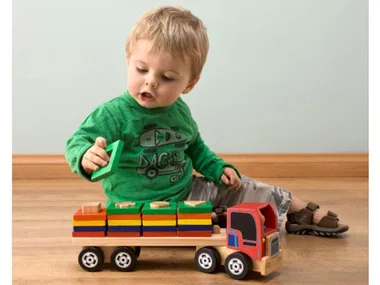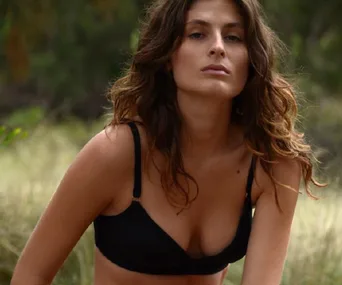In a little more than 60 years, humans have managed to fill the planet with 8.3 billion tonnes of plastic – most of which will not breakdown.
As the war on waste gains momentum, Genevieve Gannon meets some Australian women who are changing the way we think about rubbish.
Natalie Isaacs was a CEO when a wave of searing fire set her on the path to becoming a climate warrior.
She had been at the helm of her own cosmetics company for 18 years when she found herself helping out at a rally to raise awareness about rising sea levels. It was a scorching day in the spring of 2006 and she and her husband, Murray Hogarth, were down at Circular Quay in Sydney trying to drum up some media attention for the cause. Suddenly, an incredibly hot, dry wind swept across the city. Bushfire season had started.
“It was ironic because we were trying to show what climate change does and then the bushfires took over,” Natalie says. “The bushfires led the news and our little thing didn’t get a run after that. That’s when it hit me.”
After years of reading about climate change, something clicked and Natalie was shaken into action. She modified her lifestyle and cut her household electricity bill by 20 per cent. This small achievement inspired her to strive for change on a larger scale and the 1 Million Women movement was born. She now devotes her days to empowering women to wage war on waste by changing the way they live.
“Every single thing you leave on the shelf is sending a message,” the passionate redhead says.
During her years as a manufacturer, Natalie sold to many major retailers who, she says, would pressure her to cut costs and increase packaging.
“I would go to my buyer for Christmas lines and say, ‘Here’s my Christmas range with just the product’, and it would be $19.95,” she says.
“They’d say, ‘Wow, I love it. Let’s get it down to $9.95. And when you come back, can you make sure that it’s in plastic and can you put the things inside in plastic, so they don’t fall around, and then you’ll need to put the whole thing in a plastic outer and then can you put the whole thing in a plastic tray.'”
In order to make the retailer happy, she had to wrap her products in up to four layers of plastic. Her items would sell well, but Natalie says keeping the cost down meant compromising on quality and she was sure a week after buying the product, customers would throw it in the bin.
“If the customer left that product on the shelf or saw an alternative product with less packaging and started buying that instead, the department store would order more of it,” she says. “That’s consumer power.”
Women are estimated to make up to 85 per cent of the consumption decisions which affect a household’s carbon footprint. Suppliers and retailers are extremely sensitive to consumer behaviour, and Natalie is working to harness that power to bring about change.
“On average, each of us throws away 200kg of packaging a year,” she says. “We waste one in five shopping bags of food.”
Natalie is just one of many people calling for a major rethink of our waste expenditure. The first global analysis of all mass-produced plastics ever made warns that if we keep going at our current rate of consumption, the world will be awash with 12 billion tonnes of plastic by 2050.
Plastic has only been in widespread use since the 1950s, but during that time 8.3 million tonnes has been generated and despite what many think of as our diligent recycling efforts, most of it is in landfill or – worse – oceans and coastlines. Those who dutifully separate milk bottles and yogurt tubs may be surprised to learn that only 9 per cent of the plastics ever produced have been recycled.
There have been small wins for the waste-free movement recently. In July, Woolworths and Coles announced that they will phase out single-use plastic bags. Yet environmentalists argue that our disposable way of life needs to change.
Throw-away runway
Since 2000, there has been an explosion of fast fashion. Between 2000 and 2014, global clothing production doubled with more than a billion garments](https://www.nowtolove.com.au/fashion/fashion-news/environmentally-friendly-bra-australia-48657) produced in 2014 alone. The average person buys 60 per cent more items of clothing and keeps them for about half as long as they did 15 years ago, according to environmental group Greenpeace.
“There are big fast fashion houses that have 54 micro seasons. How does any woman keep up with fashion trends changing every week?” Natalie asks.
The rise of synthetic textiles means clothing doesn’t last as long as it used to and instead of being re-sold in op-shops, many poor-quality dresses, jumpers and jeans are shipped to developing countries. “This down-cycling is a temporary solution,” says Greenpeace. “Ultimately, these rags and insulation become waste, too.” The EU alone generates between 1.5 and 2 million tonnes of used clothing each year.
There is a growing movement in style circles to emphasise quality and originality over throw-away trends. Nina Gbor is a self-described eco-stylist who devotes herself to teaching people to reuse, recycle or up-cycle their clothes and save them from landfill. “For people to stop being wasteful with fashion, it’s important that they look and feel beautiful, so achieving this is a big part of what I do,” she says.
She advocates op-shopping and buying ethical brands, but is also a big fan of clothing swaps, which can be organised through schools, churches and neighbourhoods. “If everyone applied these principles on all the clothes in their wardrobes, it might drastically cut our need to buy new outfits and we would throw away far fewer clothes,” says Nina.
Sewing and vintage clothing blogger Leeyong Soo says Pinterest boards and Instagram are great for inspiring creative ways to mend or repurpose clothes. “The problem is people don’t think about mending because clothes are so cheap to just buy new. They say, ‘Why would I bother? I can just buy another one for $4’,” she says.
Read More: Could you cut plastic out of your life?
“I would always tell people to mend things and look after what you have already, not just buying things and throwing them out after a few wears.”
Natalie says that a strange and destructive trend of bragging about bargains has emerged in Western cultures. “It’s almost like we’re guilty that we bought something that’s a lot of money,” she says. “So we say, ‘It was only $20!'”
Women feel guilty about “indulging” themselves by buying expensive clothes, Natalie says, but that is exactly what everybody should be doing. “We should be buying the more expensive thing which lasts longer and outlives a fashion trend,” she says.
Plastics Surgery
Erin Rhoads is a blogger who had a similar journey to Natalie. She keeps a whole year’s worth of waste in a jar, but says she had never been a greenie until the day she watched the documentary The Clean Bin Project. “I literally jumped on the internet and typed in, ‘How can I reduce my plastic?'” the new mother says.
She came across the Plastic Free July challenge. She swapped plastic water bottles for a reusable bottle and said no to straws, reusable coffee cups and plastic-wrapped treats. After a month, Erin was hooked. “I just saw so many benefits,” says the blogger, who charts her journey online at The Rogue Ginger.
Having conquered a plastic-free life, Erin decided to live waste-free. She simplified her bathroom routine. Instead of using face wash, body wash and hand wash, she stuck to a single bar of soap. She asked her butcher to put her meat into a reusable container that she washed each week, and had her baker put her bread in a calico bag. Erin was surprised by how easy it was to change her ways simply by questioning what was necessary.
Last year, she had a zero-waste wedding. Her wedding dress was second-hand, she and her husband, known as The Builder, asked that guests donate to their honeymoon rather than bring a gift, and they took the leftover food home with them to compost. They did create some waste on the day, but the goal was to keep it to a minimum. “To me, zero waste is a goal,” Erin says.
When she became pregnant, she started taking a multivitamin. The packaging the vitamins came in could not be recycled or re-used. So she wrote to Bayer, which manufactures the supplements, and suggested its packaging could be more waste reduction-friendly. She was surprised when she received a response – her plan had simply been
to raise the issue.
“You just have that assumption politicians don’t listen or businesses don’t listen, but they do, even if they don’t act on something straight away,” Erin says. “It might be a slow change, but don’t think that it won’t ever happen.”
Bayer told The Weekly that it welcomes and logs all customer feedback, but consumer health and pharmaceutical products have strict packaging guidelines. The company reviews its packaging on an ongoing basis. “Consumers play an important role,” a Bayer spokesperson said. “There are many ways they can help bring improvements.”
Our cups runneth over
Australians are estimated to throw away one billion non-recyclable coffee cups a year. Handsome Her, a cafe on Sydney Road in Brunswick, Melbourne, is leading a campaign
to get the entire street to go disposable-free.
The 24-kilometre street is one of the southern hemisphere’s longest retail strips and home to more than 20 cafes and coffee shops. Handsome Her owner Alex O’Brien says after years of working in food service, she knew she wanted to address the waste issue when she opened her own business. “There’s so much waste [in cafes] that people don’t see. And disposable coffee cups, they just grind my gears so much,” says Alex.
Handsome Her does not use takeaway coffee cups. Instead, they’ve installed two espresso bars and an emergency mug wall of donated cups for people who absolutely need their coffee to go, but forget to bring a reusable container. “I knew I didn’t want to use disposable cups at all, but I wasn’t sure how it would pan out with people commuting,” says Alex. “I was thinking about getting jars with lids on them when one of my friends said, ‘You’re looking at it the wrong way. It’s the whole culture that needs to change. In Italy, we don’t even have takeaway coffee cups, it’s not a thing.'”
Her aim is to change the behaviour of other shops on the strip. “I’d love to see a disposable cup-free Sydney Road,” says Alex.
In the Perth suburb of Victoria Park, the owners of the Antz Inya Pants Coffee Co have eliminated disposable cups from one of their three stores. Instead, they encourage customers to buy a reusable cup. “The flow-on effect is that the reusable cups that we’ve sold and initiated here are being taken to our other stores,” owner Craig Muzeroll says.
He estimates that the disposable cup-free cafe saved around 70,000 paper cups in the first year and that the flow-on effect saved a further 50,000 at his second store. “We’ve planted the seed that to have a single-use paper cup is quite a luxury,” he says.
Craig says a lot of the reusable cups Antz Inya Pants has put into circulation are being accepted at cafes all over Perth. “It’s quite amazing for a small little corner of the world,” he says.
This article originally appeared in the October 2017 edition of The Australian Women’s Weekly.


